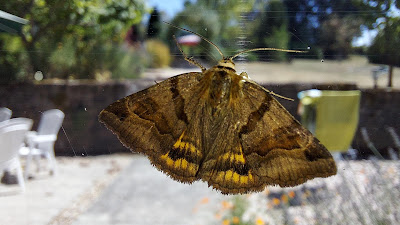Today was another very hot day with the temperature approaching 40 degrees C by late afternoon. First port-of-call of the day was a stone structure dating from the paleolithic period and referred to locally as the Dolmen de Peyralade. Birds were non-existant at this site due to the already scorching heat, although a Kestrel was hunting nearby. Plants were similarly scarce but some Southern Meadow Sage was managing to flower around the stones. Our next visit was to the hilltop village of Penne with its impressive fortress. A family of raptors flying around the fortress were probably Kestrels. Easier to observe were lots of Black Redstarts (including juveniles) plus Wall Lizard and Crag Martin. Back at La Vassiere, an attractive moth which had become trapped in the house was probably a Burnet Companion. Seven Cattle Egrets were feeding with the cows and a Buzzard flew over. A late afternoon trip to Le Bosc du Cam (still in baking heat) found evidence of breeding Swallow and Black Redstart in dilapidated farm buildings.







0 Comments:
Post a Comment
<< Home